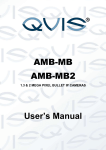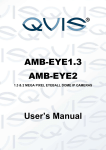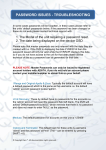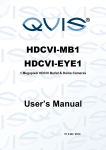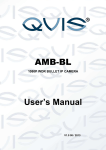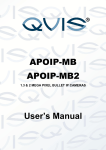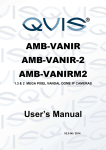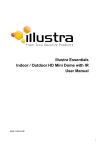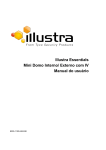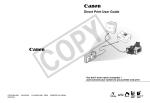Download 1.3 / 2 / 3 MEGA PIXEL EYEBALL DOME IP CAMERAS User`s Manual
Transcript
AMB-EYE1.3 AMB-EYE2 AMB-EYE3 1.3 / 2 / 3 MEGA PIXEL EYEBALL DOME IP CAMERAS User’s Manual V2.0 06 / 2014 i Welcome Thank you for purchasing the: 1.3, 2 or 3 Mega Pixel Eyeball Dome IP Cameras This user’s manual is designed to be a reference tool for the installation and operation of your system. Here you can find information about the corresponding IP camera’s features and functions, as well as a detailed installation method. Before installation and operation please read the following safeguards and warnings carefully! ii Important Safeguards and Warnings 1.Electrical safety All installation and operation here should conform to your local electrical safety codes. The power supply shall conform to the requirement in the SELV (Safety Extra Low Voltage) and must make sure that the limited power source is rated 12V DC or 24V AC. Please note: Do not connect two power supplying sources to the device at the same time; it may result in device damage! We assume no liability or responsibility for all the fires or electrical shock caused by improper handling or installation. We are not liable for any problems caused by unauthorized modification or attempted repair. 2.Transportation Security Please ensure that the product does not endure heavy stresses, violent vibration or contact with water during transportation, storage and installation. Please use the original packing material (or the material of the same quality) if you need to return it to vendor. 3.Installation Do not apply power to the product before completing installation. Do not put object(s) on the product. Please install a proper power cut-off device during the installation connection. 4.Qualified engineers needed All the examination and repair work should be done by the qualified service engineers. We are not liable for any problems caused by unauthorised modifications or attempted repair. 5. Environment This product should be installed in a cool, dry place away from direct sunlight, inflammable, explosive substances and etc. Please keep it away from environments that contain electromagnetic radiation or objects that produce it. Please keep sound ventilation around the device at all times. Do not allow the water and other liquid to penetrate into the device if casing has been compromised. This series product complies with the IP66 standard specified in the Degrees of Protection Provided by Enclosure. Ensure lightning surge protection is in place to make sure you fully protect camera circuitry from electrical overload. iii Please make sure the CCD (CMOS) component is away from the radiation of the laser beam device. Otherwise it may result in CCD (CMOS) optical component damage. It is recommended that the grounding studs of the product should be grounded, so to further enhance the reliability of the camera. 6. Daily Maintenance Please shut down the device and then unplug the power cable before you begin any maintenance work. Do not touch the CCD (CMOS) optic component. Please use an air jet to clean the dust off the lens surface. You can use the dry cloth with some alcohol or mild detergent to clear if necessary. When the camera is not in use please put the dustproof cap to protect the CCD (CMOS) component. Do not use volatile solvent such as the benzene, paint thinner or detergent with the ability to abrade surfaces. It may result in lens damage or adversely affect the device’s performance. 7. Accessories Always use all the accessories recommended by manufacturer. Before installation, please open the package and check that all the components are included. Contact your local retailer/vendor ASAP if something is missing. 8. Box Contents: Accessory Name Amount Network Camera Unit 1 User’s Manual 1 Installation Accessories Bag 1 CD 1 iv Table of Contents 1 General Introduction .................................................................................................................. 1 1.1 Overview ........................................................................................................................ 1 1.2 Features ......................................................................................................................... 1 1.3 Specifications ................................................................................................................ 2 1.3.1 Performance ........................................................................................................... 2 2 3 4 5 6 Structure ...................................................................................................................................... 5 2.1 Components .................................................................................................................. 5 2.2 Framework and Dimension ......................................................................................... 6 Device Installation ...................................................................................................................... 7 3.1 Installation Steps .......................................................................................................... 7 3.2 Restore Factory Default Setup Introduction ............................................................. 9 Quick Configuration Tool......................................................................................................... 10 4.1 Overview ...................................................................................................................... 10 4.2 Operation ..................................................................................................................... 10 Web Operation .......................................................................................................................... 13 5.1 Network Connection................................................................................................... 13 5.2 Login and Logout ........................................................................................................ 13 FAQ ............................................................................................................................................ 16 v 1 General Introduction 1.1 Overview This network camera integrates traditional camera and network video technology. It adopts both audio and video data collection and transmission simultaneously. Because of inbuilt internal hardware it can connect to a network directly without any auxiliary device. When you want to access the camera, you can use a web browser running off the network at the client-end. Due to its multiple functions it allows for various use in many environments such office, bank, road & traffic monitoring, etc. The latest chipset technology incorporated within the camera design requires low amounts of power to obtain the best video image clarity. Energy efficiency is a key element to this product, but at the same time it does not compromise on performance. This series network camera product uses the latest industry standard H.264 video and G.711a audio compression technology, which guarantee the best audio and video quality whilst reducing file sizes. One of the other main features this camera includes is the IR night vision, which aids in video surveillance when the camera is functioning within a low illumination environment. The LED IRs highlight objects of interest within the camera’s field of view and is then able to filter out any visual interference so that you can easily view footage upon a monitor. It supports real-time monitor and listening at the same time via the inbuilt microphone. If you want to communicate with a person(s) in view of the camera it also supports dualway bidirectional talk. The built-in protection enclosure and waterproof design conforms to the IP 66 level. It has sound waterproof function suitable for use in the outdoor environments. 1.2 Features User Management Storage Function Network Monitor Network Management Power Different user rights for each group, one user belongs to one group. The user’s right shall not exceed the group right. Supports: Central server backup function in accordance with your configuration and setup in alarm or schedule setting Recording via the Web and sending the recorded file to the storage at the client-end’s PC. Network storage function such as FTP. Network camera supports one-channel audio/video data transmission to network terminal and then decodes signal. Delay is within 270ms (network bandwidth support needed) Supports a maximum of 20 connections. Adopts the following audio and video transmission protocols: HTTP, TCP, UDP, MULTICAST, RTP/RTCP, RTSP, etc. Supports web access. Allows network camera configuration and management via Ethernet. Supports device management via web or client-end. External power adapter DC12V. Supports s PoE supply © Copyright Qvis ®. All documentation rights reserved. 1 Warning! Do not connect these two power supplying sources to the device at the same time; it may result in device damage! Assistant Function Please note: system cannot support these two types of power supplying at the same time. As a recommendation, if you wish for your security system to be continue to run when there is a loss of power or unstable electrical supply coming from the mains, a UPS system should be installed. Log function Supports system resource information and running status real-time display. Day/Night mode auto switch. Built-in IR light. Supports IR night vision. Supports motion detect. Supports picture parameter setup such as electronic shutter and gain setup. Backlight compensation: screen auto split allows backlight compensation to adjust the brightness. Supports video watermark function to avoid vicious video modification. The enclosure conforms to the IP66 protection testing. It can withstand a variety of weather conditions and outdoor environments. 1.3 Specifications 1.3.1 Performance Please refer to the following sheet for network camera performance specification: Model System Parameter Main Processor OS System Resources User Interface System Status AMB-EYE1.3 AMB-EYE2 AMB-EYE3 Ambarella A5s high performance DSP Embedded LINUX Support real-time network, local record, and remote operation at the same time. Remote operation interface such as WEB, PSS Bit stream statistics, log, and software version. Video Parameter Image Sensor 1/3-inch CMOS 1/2.8-inch CMOS 1/3 – inch CMOS Pixel 1280(H)x960(V) 1920(H) x 1080(V) 2048(H) x 1536(V) Day/night Gain Control White Balance BLC Supports day/night mode switch Fixed/Auto Manual/Auto On/Off Manual/Low Noise/Low motion blur/Auto PAL: It ranges from 1/3 to 1/10000 NTSC: It ranges from 1/4 to 1/10000 H.264/JPEG/MJPEG Exposure Mode Video Compression Standard © Copyright Qvis ®. All documentation rights reserved. 2 PAL: Main stream: (1280x960@15fps) Extra stream: (704×576) PAL: Main stream (1920*1080@25fps), Extra stream, (704*576@25fps) Video Frame Rate NTFC: Main stream: 1280x960@15fps) Extra stream: (704×576) Video Bit Rate Video Flip Snapshot Privacy Mask Video Setup Video Information Lens Lens Interface NTSC: Main stream(1920*1080@ 30fps), extra stream, (704*576@30fps) PAL: Main stream 1, (2048*1536@20fps), Extra stream1, (704*576@25fps) Extra Stream 2, (1280*720@11fps) Main stream 2, (1920*1080@25fps) Extra stream 1, (704*576@25fps) Extra Stream 2, (1280*720@11fps) NTSC: Main stream 1, (2048*1536@20fps), Extra stream1, (704*480@25fps) Extra Stream 2, (1280*720@11fps) Main stream 2, (1920*1080@25fps) Extra stream 1, (704*480@25fps) Extra Stream 2, (1280*720@11fps) H.264H: 40Kbps-8192Kbps adjustable MJPEG: 40Kbps-16384Kbps adjustable and bit rate is adjustable. Support customized setup. Support mirror. Support flip function. Max 1f/s snapshot. File extension name is JPEG. Supports max 4 privacy mask zones Support parameter setup such as brightness, contrast. Channel title, time title, motion detect, camera masking, tampering. 3.6mm, 6mm, 2.8mm 3.6mm, 6mm. Fixed Fixed M12. Lens is the default accessories 396 (18*22) detection zones;sensitivity level ranges from 0 to 100 Video Motion Detect Activation event: video storage, image snapshot, log, email function and etc. Record and Backup Record Priority Manual>Video detect>Schedule Storage Management Support FTP storage. © Copyright Qvis ®. All documentation rights reserved. 3 Wire Network Network Network Protocol Remote Operation Restore Default Setup IR light Power General Parameter Power Consumption Working Temperature Working Humidify Dimensions(mm) Weight Installation 1-ch 10/100 M Ethernet, RJ45 port HTTP, TCP/IP, ARP, RTSP, RTP,UDP, RTCP, SMTP, FTP, DHCP, DNS, DDNS, PPPOE, IPv4/6, SNMP, UPNP, NTP Monitor, system setup, file download, log information, maintenance , upgrade, Etc. Built-in Reset button IR light 10-20M. DC12V power and PoE. Warning! Do not connect these two power supplying sources to the device at the same time; it may result in device damage! 4W MAX, DC 12V -30 oC ~+60oC ≤95% Φ113×86 280g(Excluding box) 400g (Excluding box) Fixed on the wall, ceiling, etc. © Copyright Qvis ®. All documentation rights reserved. 280g (Excluding box) 4 2 Structure 2.1 Components You can refer to the following figure for multiple-function combination cable information (see Figure 2-1). Figure 2-1 Please refer to the following sheet for detailed information: Component Component Name Component 1 Device lens Component 2 Dome body Component 3 Dome enclosure No. Port Name Connector Note 4 LAN Network port Ethernet To connect Ethernet. 5 DC12V DC power 12V © Copyright Qvis ®. All documentation rights reserved. to standard To connect to DC12V power supply. 5 2.2 Framework and Dimension Please refer to the following two figures for dimension information. The unit is mm. See Figure 2-2 and Figure 2-3. Figure 2-2 Figure 2-3 © Copyright Qvis ®. All documentation rights reserved. 6 3 Device Installation 3.1 Installation Steps Important: Before the installation, please make sure the installation environments can support at least 3x weight of the camera. Please follow the steps listed below to install the device. Please refer to Figure 3-1 for reference. Step 1: Turn clockwise to remove the decoration ring from the snap joints. Step 2: Please take out the installation position map from the accessories bag, and then paste it on the ceiling or the wall according to your monitor area requirements. Draw and then dig three plastic expansion bolts holes in the installation surface and then insert three expansion bolts in the holes. Secure these three bolts firmly. Please draw the cable out from the cable exit when you install the device. Step 3: Adjust the device installation pedestal to the proper position and then line up the three screw holes in the device pedestal to the three plastic expansion bolt holes in the installation position. Put the three selftapping screws in the three plastic expansion bolts firmly. Loosen the M3X8 cross recessed pan head slot screw of the pedestal to unfasten the preforming. (Do not remove, loosen a little bit will be OK.). Adjust the lens to the proper monitor angle and then use the original preforming to turn the M3X8 cross recessed pan head slot screw back. Step4: Line up the three spigots of the decoration ring to the jags from the bottom to the top and then turn clockwise until you hear a clear sound ”KA”. Now the installation is complete. Figure 3-1 © Copyright Qvis ®. All documentation rights reserved. 7 Important Please pay attention to the dome camera direction when you are installing. Please refer to the following figure for detailed information. See Figure 3-2. Figure 3-2 Note This series product supports two cable exits. One is from the bottom and the other is from the side. Please refer to the following figure for cable exit from the side information. Figure 3-3 © Copyright Qvis ®. All documentation rights reserved. 8 Please earth the GND port of the device to enhance the device reliability. The GND port is near the cable exit port on the rear of the dome. The GND screw uses the M2X5 pan screw. Figure 3-4 3.2 Restore Factory Default Setup Introduction Important: Please use RESET button when device is running. Step1: Please refer to Step 1 and Step2 in Chapter 3.1 to loosen the dome body. Push a little bit; you can take the dome body from the dome cover. Step2: Take the dome body out and then turn the top cover hard to remove. Step3: Slightly press the RESET button to complete the reset function (see Figure 3-5). Step4: Turn the top cover back to the original position. Please make sure it reaches the original position, otherwise it may result in water leaking into the housing! Step5: Put the dome back to the dome cover. Please refer to Step 4 in Chapter 3.1 to install the decoration ring back. Figure 3-5 © Copyright Qvis ®. All documentation rights reserved. 9 4 Quick Configuration Tool 4.1 Overview Quick configuration tool can search current IP address and modify IP address. At the same time, you can use it to upgrade the device. Please note: the tool only applies to the IP addresses in the same segment. 4.2 Operation Double click the ‘ConfigTools.exe’ icon and you will see an interface just like the one shown as in Figure 4-1. In the device list interface, you can view the device’s IP address, port number, subnet mask, default gateway, MAC address, etc. Figure 4-1 Search interface Select one IP address and then right click mouse, you will see an interface like the one shown in Figure 4-2. Note: You can set the IP address, subnet mask and gateway for the network camera & PC. The network camera IP address and PC IP address should be in the same network segment if there is no router. Network camera default IP address is 192.168.1.108. If there is a router, please set the corresponding gateway and subnet mask. The factory default user name is admin and password is admin. For security reasons, please modify your password after you first login. For detailed WEB operation, please refer to the Network Camera Web Operation Manual in the resource CD. © Copyright Qvis ®. All documentation rights reserved. 10 Figure 4-2 Search interface 2 Select the ‘Open Device Web’ item; you can go to the corresponding web login interface (see Figure 4-3). Figure 4-3 Web login If you want to modify the device IP address without logging in to the device web interface, you can go to the configuration tool’s main interface to set. In the configuration tool’s search interface (Figure 4-1), please select a device IP address and then double click it to open the login interface. Or you can select an IP address and then click the Login button to go to the login interface. See Figure 4-4. In Figure 4-4, you can view device IP address, user name, password and port. Please modify the corresponding information to login. © Copyright Qvis ®. All documentation rights reserved. 11 Please note the port information here shall be identical with the port value you set in TCP port in Web Network interface. Otherwise, you cannot login the device. If you are using device background upgrade port 3800 to login, other setups are all invalid. Figure 4-4 Login prompt After you logged in, the configuration tool main interface is shown as below. See Figure 4-5. Figure 4-5 Main interface For detailed information and operation instructions of the quick configuration tool, please refer to the Quick Configuration Tool User’s Manual included in the resources CD. © Copyright Qvis ®. All documentation rights reserved. 12 5 Web Operation This IP camera product supports the Web access and management using a PC. Web includes several modules: monitor channel preview, system configuration, alarm, etc. 5.1 Network Connection Please follow the steps listed below for network connection: Make sure the network camera has connected to the network properly. Please set the IP address, subnet mask and gateway of the PC and the network camera respectively. Network camera default IP address is 192.168.1.108. Subnet mask is 255.255.255.0. Gateway is 192.168.1.1 Use order ping ***.***.***.***(* network camera address) to check connection is OK or not. 5.2 Login and Logout 1. Open web browser and input network camera address in the address bar. For example, if your camera IP is 192.168.1.108, then please input http:// 192.168.1.108 into the web browser’s address bar. See Figure 5-1. Input your IP address here Figure 5-1 IP address 2. The login interface is shown as below. See Figure 5-2. 3. Please input your user name and password. 4. Default factory name is admin and password is admin. Note: For security reasons, please modify your password after you first login. © Copyright Qvis ®. All documentation rights reserved. 13 Figure 5-2 Web login If it is your first time logging in, the system pops up warning information to ask you whether to install the control ‘webrec.cab’ or not, after you have logged in for one minute. Please click OK button, the system can automatically install the control. When system is upgrading, it can overwrite the previous Web as well. If you can’t download the ActiveX file, please check whether you have installed the plug-in to disable the control download. Or you can lower the web browser’s security level. See Figure 5-3. Figure 5-3 IE security level © Copyright Qvis ®. All documentation rights reserved. 14 After you logged in, you can see the main window. See Figure 5-4: Figure 5-4 Web monitoring window © Copyright Qvis ®. All documentation rights reserved. 15 6 FAQ Bug Solution / Reason I cannot boot up the device or operate it properly. Please click the RESET button for at least five seconds to restore factory default setup. The water has leaked into the camera casing The unauthorised front or rear cap removal many result in water leaking into the camera housing. The glass front cap has sustained a heavy push or strike. The waterproof plug of the rear cap becomes loosen. IR video is poor. Incorrect supply power has been used. The IR light cannot light up to its maximum level. The object is out of the IR distance range. IR-CUT does not turn to the night mode. The front end photosensitive chip cannot sense the IR light. I cannot upgrade the device via network. I cannot login the client-end or the WEB. When network upgrade operation has failed, you can use port 3800 to continue upgrade. The Active X control is blocked. The display card version needs to be DX8.1 or higher. Network connection error occurred. Invalid network setup. Invalid user name or password. I cannot play the download file. There is no player. There is no DX8.1 or higher. For the MEDIA PLAYER, there shall be Div X503Bundle.exe plugin if you play the .AVI file. For Windows XP user, you need to install the plugin DivX503Bundle.exe and ffdsho-2004 1012.exe. To guarantee setup update After you modified the important setup, please reboot the device via the software to make sure the setup has been updated to the storage medium. Power adapter The general power adapter can only work reliably within the temperature range of between 0℃ to 40 ℃. If the power supply is being operated outside this temperature range then it may result in an unstable power supply being provided to the camera. Please replace with an industrial-grade power adapter if you are using it in a harsh environment. Note This user’s manual is for reference only. Slight differences may be found in user interface. All the designs and software here are subject to change without prior written notice. © Copyright Qvis ®. All documentation rights reserved. 16 For more information about our IP Cameras and other available cameras, NVRs & accessories, please visit our website: www.adata.co.uk Alternatively scan this QR code with your smart phone to be directed instantly to our website: © Copyright Qvis ®. All documentation rights reserved. 17
























